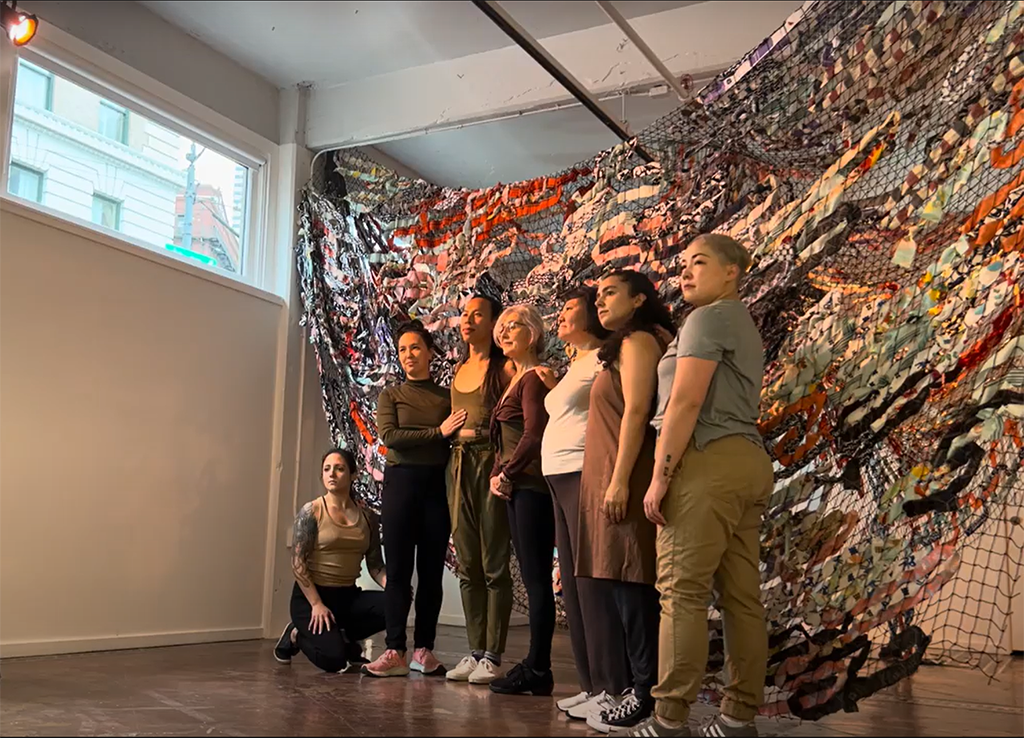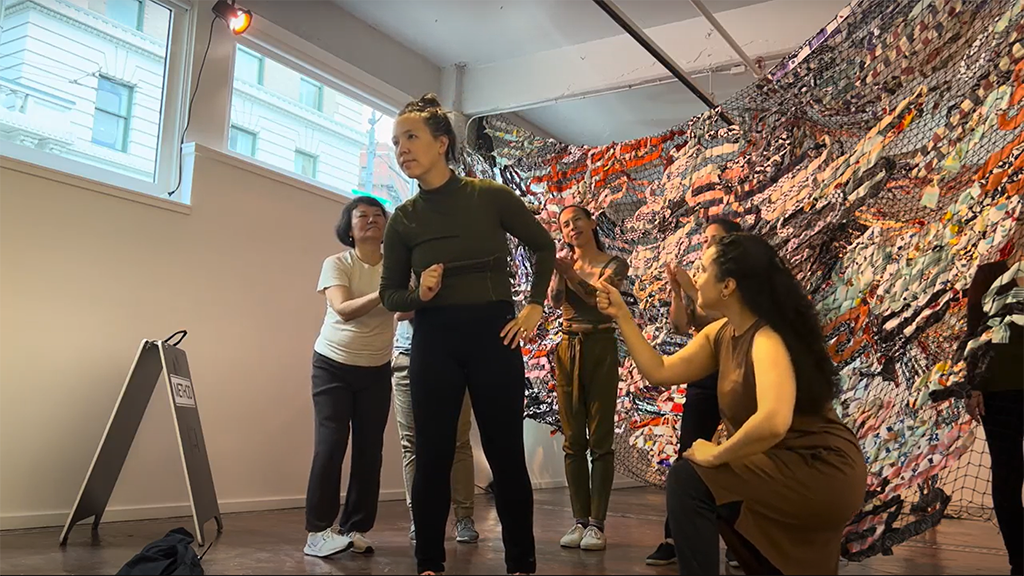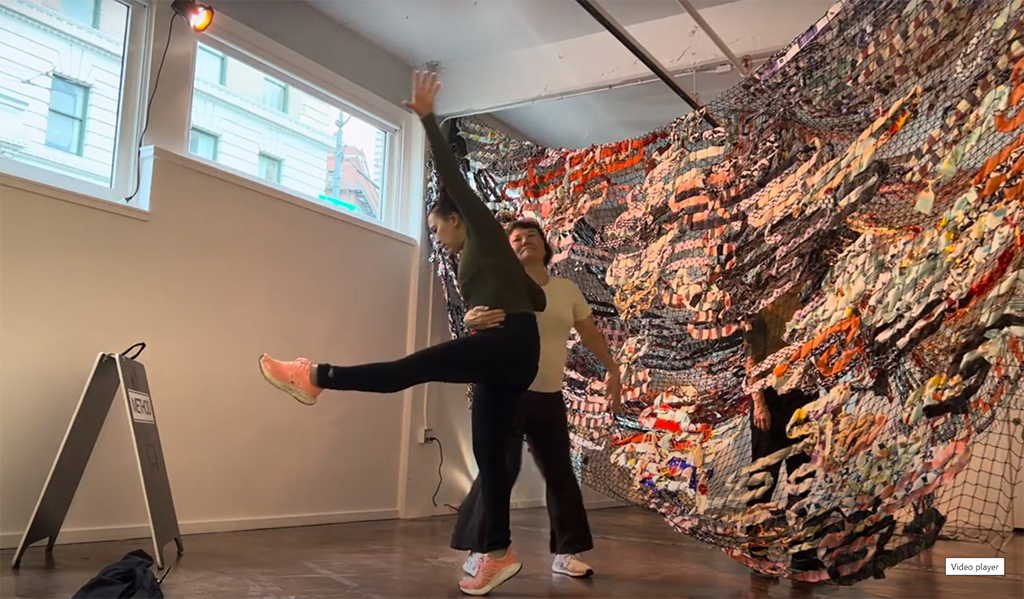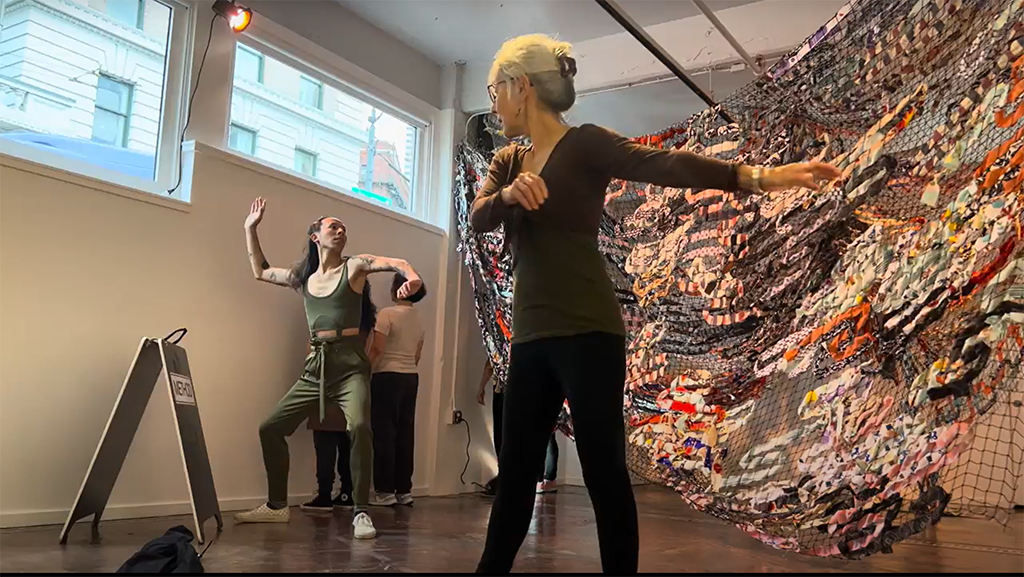By Andrew Hamlin
NORTHWEST ASIAN WEEKLY
Tara Tamaribuchi’s art installation, The Camouflage Net Project, covers, in its current form, a large portion of the Method Gallery in Seattle’s Pioneer Square. The artist conceived the Net as a meditation on Japanese American WWII incarceration, combining the wartime concept of a camouflage net with material from kimonos, suggesting Japanese American family and history.

Dancers from left, Sarah Baker, Mariko Smithashima, Truong Nguyen, Sarah Sakurazawa, Fumi Murakami, Hailey Bortel, and Gabrielle Nomura Gainor (choreographer) in front of the Camouflage Net Project created by artist Tara Tamaribuchi at Method Gallery. (Photo courtesy of Tsuru Ko)
It doesn’t seem a likely inspiration for a dance. But local dancer and choreographer Gabrielle Nomura Gainor set out, with Tamaribuchi’s blessing, to add exactly that.
Designing a dance to go with the installation wasn’t easy, said Gainor—especially since the Tsuru Ko dance troupe had to prepare without direct access to the installation. The troupe got the measurements of the Method Gallery space, then taped them off in the troupe’s rehearsal garage.
“When I first entered the gallery space to see the installation,” said Gainor, “I was awed by the beauty of the net, but initially concerned about the constraints of the gallery space. We found that there was actually more dancing space behind the net than we had accounted for in rehearsal, and made some modifications to our spacing and the choreography.
“What started off as a daunting challenge ended up being a fun, creative opportunity for me and the dancers to stretch ourselves and use this beautiful piece of artwork to create something that truly feels like a duet to me—us, the dancers as one partner, Tara’s beautiful net as the other.”
Tamaribuchi and Gainor got to know each other through a variety of communities. They’re both dancers, mothers, Buddhists, and Japanese American activists.
“The first time I ever worked with Tara was actually on a Japanese American-led community initiative,” Gainor remembered. “We worked together to oppose the installation of an origami crane project at Seattle Center. The project was created by a white artist who made no acknowledgment of the origin or history of origami cranes and their deep significance and sacredness to Japanese Americans.
“As Japanese Americans involved in this initiative, we spoke out against cultural exploitation of our community, particularly at a time when Asian Americans were hurting, facing an increase of racist attacks, and asking for our issues to be seen and heard, rather than erased.”
Tamaribuchi installed the Camouflage Net at other art spaces, but this is the first time she asked Gainor and Tsuru Ko to get involved.
“Because this is modern dance, there is a certain level of abstraction,” said Gainor. “It’s important to me to create work that is accessible and engaging to my community. But I also want to make the audience member think and come away with their own takeaway. That said, this piece will also have some recognizable elements that are not at all abstract. We use the audio of World War II propaganda, for example, in a very tongue-in-cheek way. When the announcer is describing what humane, kind treatment Japanese Americans received while incarcerated, one of my dancers is dropped on the floor and we all step over her. The point I’m trying to make is that when our government was saying one thing, it wasn’t matching up with reality.
“There is no ‘right’ answer for what the audience sees. For me, this dance reflects the dichotomy between what is natural and unnatural, and the conflict we have within ourselves as Asian Americans. It’s about allowing ourselves to feel and process for our ancestors and elders who were in survival mode. It’s about forgiving ourselves, and our community, for the ways we may have been forced to abandon our culture in moments of hardship. To get at what it means to feel, to be human, I was inspired by the idea of embodying nature, particularly water, snow, sleet, and rain—and the audience will likely be able to tell when the dancers are employing those natural elements.”

Mariko Smithashima (center), surrounded by Fumi Murakami (back, left), Truong Nguyen, Sarah Baker, and Hailey Bortel, rehearse in front of the Camouflage Net Project created by artist Tara Tamaribuchi at Method Gallery. (Photo courtesy of Tsuru Ko)

Mariko Smithashima and Sarah Sakurazawa in front of the Camouflage Net Project created by artist Tara Tamaribuchi at Method Gallery. (Photo courtesy of Tsuru Ko)

Dancers Truong Nguyen and Sarah Sakurazawa in front of the Camouflage Net Project created by artist Tara Tamaribuchi at Method Gallery. (Photo courtesy of Tsuru Ko)
The Camouflage Net Project runs through Nov. 25 at the Method Gallery, 106 3rd Avenue South in Seattle’s Pioneer Square. Tara Tamaribuchi and Gabrielle Nomura Gainor lead a conversation about the art and dance on Nov. 4. Dance performances will be featured on Nov. 17 and Nov. 18. For gallery hours, dance times, and other information, visit methodgallery.com.

